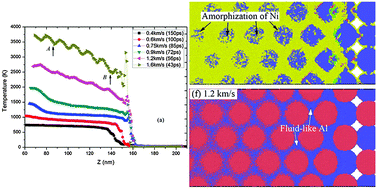Investigation of the shock-induced chemical reaction (SICR) in Ni + Al nanoparticle mixtures†
Abstract
Molecular dynamics (MD) simulations are used to investigate the shock-compression response of Ni + Al spherical nanoparticles arranged in a NaCl-like structure. The deformation and reaction characteristics are studied from the particle level to the atomic scale at various piston velocities. Shock-induced chemical reactions (SICRs) occur during non-equilibrium processes, accompanied by a sharp rise in temperature and rapid mixing of atoms. The preferentially deformed Al particles form a high-speed mass flow relative to the Ni at the shock front, which impinges on the Ni particles, and mixing of Ni and Al atoms occurs immediately at the interface. The particle velocity dispersion (PVD) that appears at the shock front has important implications for the initiation of shock-induced chemical reactions. We show that dislocations are mainly generated at the beginning of particle deformation or at the shock front, and do not directly affect the occurrence of SICRs. The intimate contact of the molten Al and the amorphous Ni is found to be critical to the subsequent reactions for the extensive mixing of Ni and Al. We conclude that the mechanisms of SICRs involve mechanochemical processes near the shock front and subsequent interdiffusion processes.

- This article is part of the themed collection: 2017 PCCP HOT Articles


 Please wait while we load your content...
Please wait while we load your content...